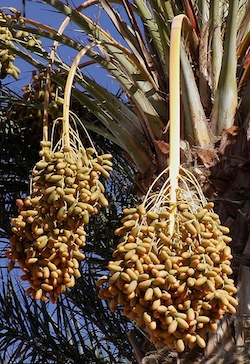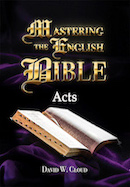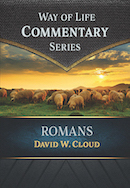866-295-4143, fbns@wayoflife.org

Fruit on a Date Palm
Dates have been cultivated for thousands of years across the Middle East and North Africa. The oldest known dates were grown in Mesopotamia, Egypt, Arabia, and the Indus Valley. Date trees were depicted on the walls of Egyptian pyramids.
Dried dates contain 61-68 percent sugar by mass, the highest percentage of any fruit. “Mainly, this sugar comes in a form of fructose and glucose, which, unlike sucrose, are not harmful to humans” (“Hot Date,” Haaretz, May 17, 2016).
They contain less than 1% fat but supply a large amount of kilocalories or food energy. “It is packed with minerals, B vitamins, antioxidants and nutritional fiber. It helps balance the digestive tract, heart and circulatory system (by lowering bad cholesterol levels), aids in preventing high blood pressure and helps protect bones by providing calcium and magnesium. .... Dates contain 23 kinds of amino acids that are not found in other fruits” (Haaretz,).
The date tree reaches about 70 feet in height and can grow singly or as a clump from several stems produced by a single root system. The bluish green leaves are 13-20 feet long. They form a canopy at the top of the tree. The clusters of fruit are about four feet long and grow below the canopy of fronds. The fruit is oval, 1-3 inches long and about 1 inch in diameter.
The date is dioecious, meaning it has separate male and female plants. The male bears the pollen and the female bears flowers that can be pollinated for fruit bearing. The male bears the pollen on cream-colored flowers. The male flower clusters are 9 inches or less in length. The female flowers are white and the clusters are 12-30 inches. Natural pollination is by wind in groves of mixed male and female, but in modern horticulture, farmers cultivate only (or mostly) females and pollinate them manually. One male palm tree can pollinate 50 females.
Dates grow best from cultivars rather than seeds. The cultivar-grown trees are healthier and flower two or three years earlier. Seeds are about 50% male and female, since they were designed by God for natural pollination.
The date palm is long lived and very productive and can produce 100 to 200 POUNDS per tree in one season. They start bearing fruit at 5 to 8 years of age and increase in production as they mature, reaching peak production between 30 and 35 years, and declining by age 60. They reach the end of their reproductive life by age 80.
For this level of production, they require a lot of water. The Israeli-invented drip irrigation is ideal for supplying this water directly and scientifically to each tree.
“To prolong shelf life, many dates are left on the palm until completely ripe. Thus they are slightly dry before being harvested; these dates are still considered fresh” (M. Watson, All about Fresh Dates).
The date remains a very popular fruit in modern times. In 2019, world production was 9 million tons. The largest producers are Egypt, Iran, Algeria, Saudi Arabia, the United Arab Emirates, Israel. Large amounts of dates are grown in California in the USA.
Dates are used as fresh and dried fruit and for deserts, spreads, bread, syrup, juice, and vinegar. They are pitted stuffed with a wide variety of edible goodies, such as almonds, pecans, candied orange, and cream cheese. They are glazed with powered sugar or syrup or chocolate. Date seeds are used for animal feed. “The oil is used in cosmetics and dermatological applications.” The date leaves are cooked and eaten as a vegetable, and flower buds are used in salads.
The Palm Tree in Scripture
Palm trees marked desert oases and provided nourishment for Israel in the wilderness (Ex. 15:27; Nu. 33:9). Jericho was called the city of palm trees (De. 34:3; Jg. 1:16; 3:13; 2 Ch. 28:15). Deborah dwelt under a palm tree in mount Ephraim (Jg. 4:5).
The palms were used prominently in the Feast of Tabernacles (Le. 23:39-40), which was Israel’s celebration of entering the Promised Land after the 400-year slavery in Egypt and the 40-year wandering in the wilderness, with its labor, struggles, and death. The palm frond was used in ancient Rome’s triumphal processions to signify their military victories.
Christ was met with branches of palms when He entered Jerusalem on the Sunday before His crucifixion (Joh. 12:13), a foreview of His victorious return as Israel’s King. (Roman Catholics, Orthodox, and some Protestants use palm fronds in Palm Sunday celebrations.)
Palms were prominently displayed in Solomon’s temple. Images of palms were carved on the walls (1 Ki. 6:29), on the doors (1 Ki. 6:32, 35), and on the brass lavers (1 Ki. 7:36).
Images of palms will also be carved in the Millennial Temple (Exe. 40:16, 22, 26, 31, 34, 37; 41:18, 19, 20, 26).
The palm trees in the temples signify Christ’s eternal victory over sin and death. The palms signify the eternal victory and security every believer has in Christ. The walls of the millennial temple will exclaim the glorious truth that bondage and warfare are forever past because of Christ! Palms also signify Christ’s satisfaction and nourishment as spoken by the sweetness and rich nutrition of the palm’s date fruit. The palm signifies Christ as the water of life providing sustenance and refreshment in the wilderness wandering (Nu. 33:9). The palm also signifies Christ flourishing forever and God’s people flourishing in Him (Ps. 92:12-14).
The Palm in Israel Past and Present
The Judean dates “were known for their wonderful sweetness, their very large size, and their ability to be stored for a long time, so they actually were exported around the Roman empire” (“Dates Like Jesus Ate,” National Public Radio, Feb. 6, 2020).
Groves of Judean dates once flourished in Israel, as described by Pliny and Josephus, and were famous across the Roman Empire.
The date palm was even used as a symbol for Israel. An ancient Israeli coin depicted a palm tree with two baskets of fruit beneath. This has been reissued in recently years as a 10 shekel coin. Between 1980 and 1985, Israel minted a 1 agora coin depicting the date palm. The agora or agorot was 1/100th of a shekel.
After the first Roman-Jewish War, the Romans minted a coin associating the palm tree with Israel. Emperor Vespasian issued the coin beginning in 71 AD and some might have been minted from gold taken from Israel’s temple before its destruction the year before. The words Ivdaea Capta (“Judea has been conquered”) or Ivdaea Devicta (“Judea has been defeated”) were engraved around the rim. Israel was depicted as a weeping woman sitting by a palm tree with her hands tied behind her back.
The date palm was reintroduced to Israel in the 1930s and 1940a when groves began to be planted in the Jordan Valley, the Arava (south of the Dead Sea), and the region of Bethshean in the Harod Valley by Israeli kibbutzim. Kibbutz Kinneret was one of the pioneers. By the 20th century when Israelies were returning to Israel and establishing kibbutzim, date growing had died out of Israel. Date cultivars were closely guarded by neighboring countries. It was illegal to export them, so they had to be smuggled in.
“Most countries growing palm trees didn’t allow taking out stalks of the trees, often under the death penalty. Palm trees were considered a national treasure. In the 30s, Ben-Zion started to travel to Arab countries to buy cuttings of the palm trees. During a few risky trips, he managed to bring several thousand root offsprings from different countries” (“Israel Dates,” yardenit.com, July 10, 2015).
Today there are hundreds of acres of date palms in Israel and the number is increasing rapidly. They can be found from Eilat to the Sea of Galilee.
Many of them are the medjool (medzhul) variety, known as the king of dates. Israel produces 65-75% of the world’s consumption of medjool (“Hot Date,” Haaretz, May 17, 2016). Israel also grows the Tunisian Deglet Nour; Halawi, Ameri, Khadrawi (chocolate brown), and Zahidi (yellow).
The Methuselah Tree
The most famous date palm is the Methuselah Tree that was grown from a 2,000-year-old seed. The seeds were found by archaeologists in the 1960s in Masada, Herod the Great’s desert fortress overlooking the Dead Sea. They date to before Christ, so they are 2,000 years old. Masada was stocked with every type of food and wine that the luxury-loving Herod craved, but the fortress was abandoned after his death. It was briefly occupied in 73-74 AD for the last stand of Jewish revolters in the First Roman-Jewish War. When the revolters committed mass suicide, the burned fortress was left to crumble into the dust. The Judean Date Palm itself went extinct sometime between 1000 and 1400 AD. They were destroyed by centuries of war, neglect, and desertification. About 20 years ago, Dr. Sarah Sallon, a natural medicine researcher, had the idea of planting some of the ancient seeds to see if they had medicinal benefits not found in other dates. With difficulty, she convinced the skeptical Masada archaeologists to give up their precious find for this purpose. Dr. Elaine Solowey, with the Arava Institute at the Kibbutz Ketura in the Israeli Negev, oversaw the planting. One of three seeds sprouted and grew into a healthy date palm that began flowering and producing pollen in 2011. They named it Methuselah after the oldest living man in recorded history (Ge. 5:27). The problem, as its name suggests, is that the tree is a male and needs a female to produce fruit. Solowey convinced other archaeologists to give up ancient seeds they found in Qumran, a few miles north of Masada, and they have been successful in growing females. One is named Hannah, after the prophet Samuel’s mother. In 2020, Hannah was successfully pollinated by Methuselah and in September she bore 111 dates of the ancient Judean variety! They are said to be very tasty with a slight honey flavor.
As of 2021, there are multiple thriving male and female date palms grown from ancient seeds, and the vision is to produce groves of them for science and commerce.
It is the story of the resurrection of ancient Israel and points to Israel’s imminent conversion. As Ezekiel prophesied, in the vision of the valley of dry bones, Israel would return in a spiritually dead condition, then be given life (Eze. 37:1-14).
- Receive these reports by email
- www.wayoflife.org
______________________
Sharing Policy: Much of our material is available for free, such as the hundreds of articles at the Way of Life web site. Other items we sell to help fund our expensive literature and foreign church planting ministries. Way of Life's content falls into two categories: sharable and non-sharable. Things that we encourage you to share include the audio sermons, O Timothy magazine, FBIS articles, and the free eVideos and free eBooks. You are welcome to make copies of these at your own expense and share them with friends and family. You may also post parts of reports and/or entire reports to websites, blogs, etc as long as you give proper credit (citation). A link to the original report is very much appreciated as the reports are frequently updated and/or expanded. Things we do not want copied and distributed are "Store" items like the Fundamental Baptist Digital Library, print editions of our books, electronic editions of the books that we sell, the videos that we sell, etc. The items have taken years to produce at enormous expense in time and money, and we use the income from sales to help fund the ministry. We trust that your Christian honesty will preserve the integrity of this policy. "For the scripture saith, Thou shalt not muzzle the ox that treadeth out the corn. And, The labourer is worthy of his reward" (1 Timothy 5:18). Questions? support@wayoflife.org
Goal:Distributed by Way of Life Literature Inc., the Fundamental Baptist Information Service is an e-mail posting for Bible-believing Christians. Established in 1974, Way of Life Literature is a fundamental Baptist preaching and publishing ministry based in Bethel Baptist Church, London, Ontario, of which Wilbert Unger is the founding Pastor. Brother Cloud lives in South Asia where he has been a church planting missionary since 1979. Our primary goal with the FBIS is to provide material to assist preachers in the edification and protection of the churches.
Offering: Offerings are welcome if you care to make one. If you have been helped and/or blessed by our material offerings can be mailed or made online with with Visa, Mastercard, Discover, or Paypal. For information see: www.wayoflife.org/about/makeanoffering.html.





